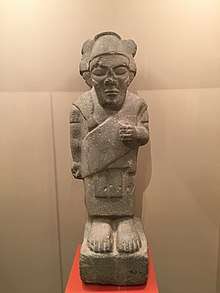List of rulers of Ammon
The following is a list of rulers currently known from the history of the ancient Levantine kingdom Ammon. Ammon was originally ruled by a king, called the "king of the children of Ammon" (Ammonite: 𐤌𐤋𐤊 𐤁𐤍𐤏𐤌𐤍; Hebrew: מֶלֶךְ בְּנֵי עַמֹּון melekh bənê-ʿAmmôn). After the conquest of the Neo-Babylonian and Achaemenid Empires, Ammon was maintained by an administrator (עֶבֶד ʿebhedh, literally "servant"; Greek: ἡγούμενος hēgoúmenos, "leader"). Only a modest number of Ammonite kings are known today, mostly from the Bible and epigraphic inscriptions.[1][2]

Statue of an Ammonite deified King on display at the Jordan Museum. The statue was found near the Amman Citadel and is thought to date to 8th century BC.
Rulers of Ammon
Kings of Ammon
- unnamed Ammonite king of Judges 11:12–28
- Nahash (Hebrew: נָחָשׁ Nāḥāš; mid eleventh century B.C.)
- Hanun son of Nahash (Hebrew: חָנוּן Ḥānûn; early tenth century B.C.)
- Shobi son of Nahash[3] (Hebrew: שֹׁבִי Šōbî; early tenth century B.C.)
- Rehob (Akkadian: Ruḫubi; c. 850s B.C.)
- Baasha son of Rehob (Akkadian: Baʿša; 853 B.C.)
- Shanip (Ammonite: 𐤔𐤍𐤁 Šeneb; Akkadian: Šanipu; c. 734 B.C.)
- Zacchur son of Shanip[3][4][5] (Ammonite: 𐤆𐤊𐤓 Zakkûr)[6]
- Jeraheazar son of Zacchur[3][4][5] (Ammonite: 𐤉𐤓𐤇𐤏𐤆𐤓 Yəraḥʿāzār)[7]
- Barachel (𐤁𐤓𐤊𐤀𐤋 Bārakʾēl; c. 670s)
- Amminadab I (Ammonite: 𐤌𐤍𐤃𐤁 ʿAmmînādāb; c. 650 B.C.)
- Hissalel son of Amminadab (Ammonite: 𐤄𐤑𐤋𐤀𐤋 Həṣalʾēl; c. 620 B.C.)[9]
- Amminadab II son of Hissalel (c. 600 B.C.)
Administrators of Ammon
gollark: Ah, heavserver.
gollark: ++tel link apionet #a
gollark: <@160279332454006795> 🐝<:apioform:812013353165389875> you.
gollark: >daily
gollark: Weird.
References
- Deutsch, Robert. "Seal of Baʿalis Surfaces". Robert Deutsch: Archaeological & Epigraphic Monographs, Publications & Photographs. Archived from the original on 2011-05-18. Retrieved 2017-04-12.
The list of known Ammonite kings is short, so the discovery of a new one is especially important. Some are mentioned in the Bible. In addition to Ba'alis, the Bible also refers to an Ammonite king named Nahash. […] Nahash's son, who succeeded him as king, is identified as Hanun. […] A number of other Ammonite kings are known from cuneiform inscriptions. The total, until the appearance of Barak-el, was nine. Now it is ten.
- Way, Kenneth C. (2016). Judges and Ruth. Baker Books.
Many Ammonite royal names are attested in epigraphic and biblical sources (e.g., Nahash, Hanun, Shanip, Padoel, Amminadab, Hissalel, Baalis).
- Block, Daniel (2013). The Gods of the Nations: A Study in Ancient Near Eastern National Theology. Baker Books. p. 64 (footnote). ISBN 978-1-62032-974-0.
The names of the known kings of Ammon are (in chronological order) Nahash, Hanun, Shobi, Shanib, Zakur, Yariḥ-Ezer(?), Pudu-Ilu/Buduilu, ʿAmminadab I, Hissal-El, ʿAminadab II, Baalis/Baal-Yashaʿ.
- Boardman, John; et al., eds. (1991). The Cambridge Ancient History: The Assyrian and Babylonian Empires and Other States of the Near East, from the Eighth to the Sixth Centuries B.C. Vol. III.2. Cambridge University Press. p. 336. ISBN 0-521-22717-8.
The name of the king of Ammon, šnb, is preserved on a statue, probably representing the king, which was found near Jebel el-Qalʿa, the citadel of Rabbah, modern Amman, the ancient capital of Ammon. This statue bears a damaged inscription on its base, of which the major part may plausibly be restored to read yrḥʿzr [br z]kr br šnb, 'Yerah-ʿazar [son of Za]kkur son of Shanib', thus giving the names of the son and grandson of Shanib (Sanibu).
- Barton, John (2002). The Biblical World. Vol. 1. Routledge. p. 515. ISBN 0-415-35090-5.
Sanipu reigned in the time of Tiglath-pileser III (722 BCE). A certain Yarih-azar is mentioned in a statue from the eighth century BCE. He is the son of Zakkur, the son of Sanipu, possibly the same Sanipu mentioned above.
- Tentatively based on the inscription Yəraḥʿāzār [bar Za]kkûr bar Šenebh, "Jeraheazar [son of Za]cchur son of Shanib".
- Variously interpreted Yəraḥʿāzār or Yariḥ-ʿezer.
- Variously interpreted Pədûʾēl (also written Padôʾēl), Pădāʾēl, or Pədāʾēl.
- Variously interpreted Hiṣalʾēl ("Hissalel"), Haṣalʾēl ("Hassalel"), or Haṣilʾēl ("Hasilel").
This article is issued from Wikipedia. The text is licensed under Creative Commons - Attribution - Sharealike. Additional terms may apply for the media files.